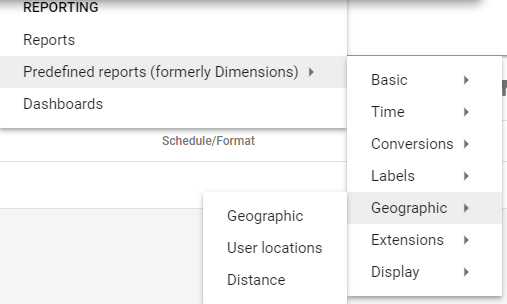This winter break reading list is designed to help CMOs start the new year sharper, more informed, and ahead of the competition

One of the greatest areas of optimization opportunity when it comes to AdWords campaigns involves tweaking the Geo-Targeting Settings based upon performance. For example, many campaigns are set to target only “United States” with a 0% bid modifier. It's a common practice for account managers to bid at the state level with seemingly random bid modifiers based upon perception of performance or perception of need, instead of actual performance. In today’s hypercompetitive ad marketplace, such a strategy shortchanges your business performance. We can show you how to do better.
First, assuming you’re in the new AdWords UI, go to the following location:

You’re going to see a Geographic Report of your data based upon the dates you’ve selected. Looking at the data contained in your report, you might see something along the lines of:

Within this little report snippet, we can see how deep Google can segment the data geographically. We can get data at the Country Level (e.g. US); Region / State (e.g. Hawaii), Metro Area (e.g. San Francisco DMA), City (Napa), Neighborhood (e.g. Old Toronto), US Congressional Districts, or Zip Code (e.g. 94558).
Next, create a quick pivot table counting the number of conversions at the “Most Specific Location” Level. What is the deepest level of specificity that you’re seeing sufficient conversion volume? If you’re seeing individual neighborhoods or zip codes getting batches of conversions (as opposed to lots of 1’s and 2’s), you can successfully bid to the most specific levels of AdWords geography. If the Neighborhood / Zip Code data is sporadic, then, you might eliminate the “Most Specific Location” column from your data and bid to the City or DMA Level. Unless you have low conversion volume, you should be able to increase the efficiency of your campaign by geo-bidding to the City or DMA Level (as opposed to the state or country).
Here’s another thing useful tidbit of information: AdWords isn’t able to track 100% of its users to the most specific location levels. For example, if you click on an ad while on your cell phone while on the Interstate in a rural area (hopefully not while driving), Google might just be able to track you just to the State that you’re in (or perhaps not even that). Therefore, even if you decide to implement a very specific course of geo-bidding, you’ll need to include Countries and States as part of your structure as a catchall for all your traffic that will get missed with the most specific geo-targeting.
When you decide on how deep to segment your data, pull a report that contains the geo-segments, cost, conversions, and CPA (including Total CPA). We need to figure out what bid modifier to use for geo segment.

In our example, our account CPA happens to be $30.33 and as you might expect, the top Geo’s for the account tend to have better than average CPA’s. We calculate the bid modifier for each of these Geo’s by taking ($30.33 – Geo CPA) / Geo CPA * 100 which gives us some pretty large numbers in the bid modifier column.
However, experience tells us that having bid adjustments greater than 100 or less than -70 isn’t a good idea. Super high bid modifiers lead to unpredictable results and super low bid modifiers tend to quash traffic. So, for the geographic locations that fall outside that range, we make some manual modifications…

Now, we need to get the data ready to upload to AdWords. You are going to upload your data into the locations tab for every campaign you wish to adjust. AdWords has a check locations functionality, but it’s far from perfect if, for example, you just decide to upload your geo as “Napa”. So, you’re going to want to do the following with your data spreadsheet:
Arrange all the remaining data columns from left to right in the order of most specific to least specific (e.g. Most Specific Location / City / Region / Country).
Merge the fields into one with commas separating each data point. We usually do this by pasting the data in Notepad, making the adjustment, and then pasting the altered data back into Excel.
Then, upload the data into AdWords (and validate the data with tools or other platforms).
Manually check your locations for errors. I’ve found that Google fails to distinguish Washington / Washington DC, Kansas / Kansas City, Oklahoma / Oklahoma City, Indiana / Indianapolis, and New York / New York City, among others. You may need to do some manual tweaks.
Then, upload your data.
We’ve seen as much as a 15-20% increase conversion yield from a thorough bidding modifier scrub / update. We also see the overall spend trend slightly higher, so make sure you adjust your budgets accordingly. Account dynamics change over time, and we recommend period reviews and adjustments of bid modifiers in all AdWords Accounts.
It’s easy to miss all the opportunities available for optimization in AdWords, especially given all of the work on your plate as an SEM professional. But you simply can’t afford to miss them because by finding the time to fine-tune your targeting and bid adjustments, you can make huge improvements in your overall program performance.